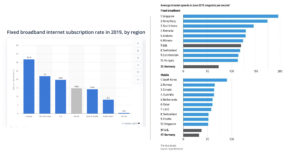Enabling an on-ramp to the new Digital Society
Over the past few years, much has been written about the digital divide between urban and the rural communities, the affluent and the economically disadvantaged, and between the developed and the developing nations. Now, the COVID-19 pandemic has cast a unique spotlight on the divide’s ominous shadow in an unprecedented way. With most nations implementing various forms of shelter-at-home regulations, many essential activities have been driven online and into people’s residences. This has fundamentally forced us to re-imagine how we work, learn, socialize, and get entertained. As social norms and business practices change, it is widely expected that these new behaviors will survive the pandemic and create a new normal. In a way, this emergency is serving as rocket fuel, accelerating the inevitable trend towards tele-work, tele-education, tele-health, and esports, all requiring reliable and ubiquitous Internet access.

“The debate on whether residential broadband is a luxury or an essential connection to society is over”, declares Benton Institute for Broadband & Society, “this is the time to invest in, plan for, and engineer High-Performance Broadband for every person in America.” The U.S. Congress is discussing an $86 billion broadband infrastructure investment bill. It seems to have broad support, with the executive branch reportedly contemplating a significant broadband investment as part of the administration’s trillion-dollar infrastructure stimulus plan. The World Bank reports that Africa will require $100 billion in investment to achieve universal and affordable internet access. Across the globe, similar calls and several multi-billion-dollar commitments are being made by governments and business leaders to fund massive infrastructure buildout for ultra-broadband to deliver 100Mbps to 1Gbps to a vast majority of the population. 
Required: Improved Broadband penetration and faster speeds across the majority of the globe
As this global phenomenon to drive deep broadband penetration is gaining steam, it is timely to contemplate the most efficient ways to bring reliable and performant broadband to the un-connected or under-connected. U.S. Rep. Ro Khanna, who represents much of Silicon Valley, recently stated: “I don’t think it’s for the federal government to decide what’s the best way — whether it’s 5G, whether it’s fiber, whether it’s traditional cable, I don’t think it’s a one-size-fits-all solution.” I whole heartedly agree; defining, developing and operating the optimal solution for each community is best left to the appropriate technical experts and local agencies supported by close-to-the-ground operators and suppliers.
What is the right access technology? What architecture offers flexibility to effectively ride the wave of rapid technology innovation without requiring wholesale rip and replace of the infrastructure every few years? How can new services, some not yet conceived, be easily on-boarded on this infrastructure? What approach is most cost-effective? What is the right eco-system and business model to deliver this massive upgrade? Answering these questions and delivering software platforms that enable innovative solutions has been at the core of Open Networking Foundation’s mission for the past 9+ years. ONF, led by the world’s tier-1 operators and supported by an eco-system of over 100 organizations, is collaboratively focused on transforming access and edge networks for next generation mobile and broadband infrastructure. As operators undertake upgrading and extending their broadband infrastructure to respond to these new requirements, they are looking for vastly favorable economics, the agility of cloud-native design & deep automation to enable mass market adoption and efficiency of operation. Open networking uniquely holds the key to deliver these requirements. Hence, forward-looking operators are investing in and procuring solutions that leverage innovative ONF platforms such as ONOS, SDN Enabled Broadband Access (SEBA), Trellis, and COMAC. These platforms embrace disaggregation, SDN, NFV and Cloud technologies implemented as open source software on white box hardware, allowing the solutions to enable unprecedented capex and opex efficiencies, rich programmability and modularity, all while avoiding vendor lock-in. To learn about these innovative platforms and solutions that will help you participate and benefit from the unparalleled opportunity being created by this infrastructure upgrade, join our industry’s thought leaders and technical experts for deep conversations at the timely ONF Spotlight – Broadband virtual event, starting July 7th, 2020. Free registration provides access to live free keynotes and rich on-demand content. This is a unique opportunity to hear from the experts and learn about the open platforms, solutions, and commercial ecosystems that ONF has enabled. Whether you are an architect, product manager or a developer, you will learn something new and get a chance to contribute your unique perspective to our community. See you soon!
